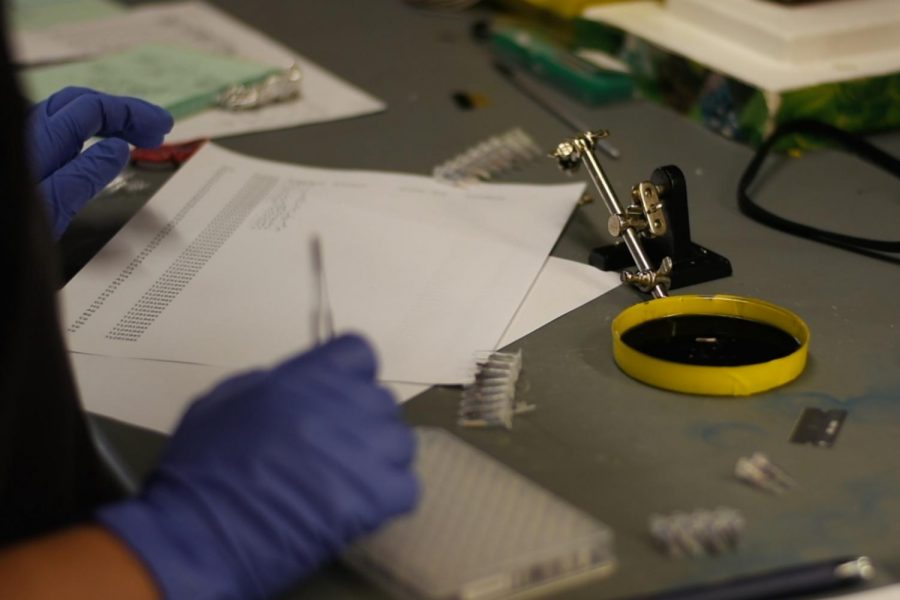Women are discriminated against in their everyday shopping whether they realize it or not; the Pink Tax is one such example showing the cost difference between men’s and women’s products. Things such as women’s razors cost more than men’s razors, which demonstrates the business idea of market segmentation, where certain products are targeted towards certain consumers. However, why do women have to pay an extra $1,351 per year, on average, for these products?
Subtle Sexism Ep. 2: The cost of being a woman
Navigate Left
-
 BroadcastDía De Los Muertos festival raises community spirits
BroadcastDía De Los Muertos festival raises community spirits -
 BroadcastLove of table tennis transcends international barriers
BroadcastLove of table tennis transcends international barriers -
 BroadcastFlooding of weight room disrupts student classes and sports
BroadcastFlooding of weight room disrupts student classes and sports -
 BroadcastMagic the Gathering Club draws students to the magic of card games
BroadcastMagic the Gathering Club draws students to the magic of card games -
 BroadcastCarlmont faculty ends the year on a high note
BroadcastCarlmont faculty ends the year on a high note -
 BroadcastMusic program inequity persists in the BRSSD district
BroadcastMusic program inequity persists in the BRSSD district -
 BroadcastInside the Life of Duke Commit Kaylee Kim
BroadcastInside the Life of Duke Commit Kaylee Kim -
 BroadcastCarlmont choir spreads a sense of community with PB and Jams concert
BroadcastCarlmont choir spreads a sense of community with PB and Jams concert -
 BroadcastPro-Palestine Encampments emerge at local universities
BroadcastPro-Palestine Encampments emerge at local universities -
 BroadcastCapo Belmont restaurant builds community within Carlmont
BroadcastCapo Belmont restaurant builds community within Carlmont -
 CommunityJourney to success of a Bay Area artist
CommunityJourney to success of a Bay Area artist -
 CommunitySpring season kicks off for the local AYSO EPIC team
CommunitySpring season kicks off for the local AYSO EPIC team -
 CommunityTree lighting at Hillsdale Shopping Center sparks festive spirits
CommunityTree lighting at Hillsdale Shopping Center sparks festive spirits -
 CommunityThe Makerspace Project brings innovation to Redwood City community
CommunityThe Makerspace Project brings innovation to Redwood City community -
 CommunityFamilies trick-or-treat down Laurel Street at the Goblin Walk
CommunityFamilies trick-or-treat down Laurel Street at the Goblin Walk -
 CommunityOrchard Days brings fall spirit to Filoli
CommunityOrchard Days brings fall spirit to Filoli -
 CommunityFarmers markets spark opportunity for small vendors
CommunityFarmers markets spark opportunity for small vendors -
 CommunityStudent Profile: Victoria Tsou lands passion for taiko
CommunityStudent Profile: Victoria Tsou lands passion for taiko -
 CommunityMavericks Festival makes waves in the community
CommunityMavericks Festival makes waves in the community -
 CommunityInside Green Fashion Nursery’s family-run plant oasis
CommunityInside Green Fashion Nursery’s family-run plant oasis -
 SeriesHome Café Ep. 4: Lychee Passion Green Tea
SeriesHome Café Ep. 4: Lychee Passion Green Tea -
 SeriesComplex Mindz Ep. 4: Trichotillomania part two
SeriesComplex Mindz Ep. 4: Trichotillomania part two -
 SeriesHome Café Ep. 3: Matcha Strawberry Layered Latte
SeriesHome Café Ep. 3: Matcha Strawberry Layered Latte -
 SeriesHome Café Ep. 2: Caramel Macchiato
SeriesHome Café Ep. 2: Caramel Macchiato -
 SeriesHome Café Ep. 1: Classic Boba Milk Tea
SeriesHome Café Ep. 1: Classic Boba Milk Tea -
 SeriesBay Area Bites Ep. 3: Spoon & Fork
SeriesBay Area Bites Ep. 3: Spoon & Fork -
 SeriesHow We See It Ep. 2: Music Taste and Personality
SeriesHow We See It Ep. 2: Music Taste and Personality -
 SeriesDiverse Creativity Ep. 5: Nobel Prize winner Dr. David Julius
SeriesDiverse Creativity Ep. 5: Nobel Prize winner Dr. David Julius -
 SeriesHow We See It Ep. 1: The things our parents say
SeriesHow We See It Ep. 1: The things our parents say -
 SeriesBay Area Bites Ep. 1: Drakes family restaurant
SeriesBay Area Bites Ep. 1: Drakes family restaurant
Navigate Right
About the Contributor

Bella Reeves, Editor-in-Chief
Bella Reeves is a senior at Carlmont High School who loves to make videos and tell amazing stories for the world to experience. As the Editor-in-Chief of ScotCenter, she aims to humanize the news through her videos. She's always been a hardworking student and her extra-curricular activities are also to par; she works as a social media intern at BraveMaker and is a 2019 graduate of the California Scholastic Press Association workshop. Reeves hopes to major in TV Broadcasting and one day become an Academy Award-winning documentarian. To check out her portfolio, click here.
Twitter: @bellareevesss

Winston Singh • Mar 3, 2020 at 9:19 pm
The pink tax is false and the reason why is with the fact that women’s products cost a lot more to make than compare to men’s products. Like a female razor tend to have a lot more gel in their razor’s than men’s razor’s. Also men shave a lot more then women do and while the male razor does cost less that doesn’t mean they spend more in an year than a women does and because of this women spend less overall on razor’s per year. An average razor cost’s $110.94 per year while on average men spend about $179.88. Also shampoo there are different things that companies use like in your video you see that the shampoo you show is coconut infused or an oil infused lotion. This cost’s the company way more to make which in order for them to make a profit they have to raise the profit. Also if you don’t want to pay extra just buy the men’s shampoo if you want to. For the most part the pink tax is not about sexism but is mostly about the company trying to make a profit.